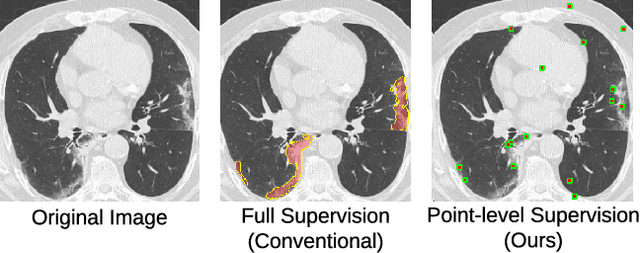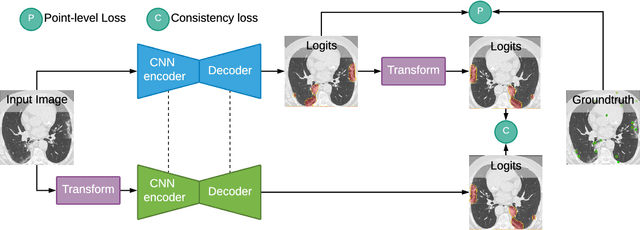Lironne Kurzman
A Weakly Supervised Consistency-based Learning Method for COVID-19 Segmentation in CT Images
Jul 07, 2020



Abstract:Coronavirus Disease 2019 (COVID-19) has spread aggressively across the world causing an existential health crisis. Thus, having a system that automatically detects COVID-19 in tomography (CT) images can assist in quantifying the severity of the illness. Unfortunately, labelling chest CT scans requires significant domain expertise, time, and effort. We address these labelling challenges by only requiring point annotations, a single pixel for each infected region on a CT image. This labeling scheme allows annotators to label a pixel in a likely infected region, only taking 1-3 seconds, as opposed to 10-15 seconds to segment a region. Conventionally, segmentation models train on point-level annotations using the cross-entropy loss function on these labels. However, these models often suffer from low precision. Thus, we propose a consistency-based (CB) loss function that encourages the output predictions to be consistent with spatial transformations of the input images. The experiments on 3 open-source COVID-19 datasets show that this loss function yields significant improvement over conventional point-level loss functions and almost matches the performance of models trained with full supervision with much less human effort. Code is available at: \url{https://github.com/IssamLaradji/covid19_weak_supervision}.
Class-Based Styling: Real-time Localized Style Transfer with Semantic Segmentation
Aug 30, 2019


Abstract:We propose a Class-Based Styling method (CBS) that can map different styles for different object classes in real-time. CBS achieves real-time performance by carrying out two steps simultaneously. While a semantic segmentation method is used to obtain the mask of each object class in a video frame, a styling method is used to style that frame globally. Then an object class can be styled by combining the segmentation mask and the styled image. The user can also select multiple styles so that different object classes can have different styles in a single frame. For semantic segmentation, we leverage DABNet that achieves high accuracy, yet only has 0.76 million parameters and runs at 104 FPS. For the style transfer step, we use a popular real-time method proposed by Johnson et al. [7]. We evaluated CBS on a video of the CityScapes dataset and observed high-quality localized style transfer results for different object classes and real-time performance.
 Add to Chrome
Add to Chrome Add to Firefox
Add to Firefox Add to Edge
Add to Edge